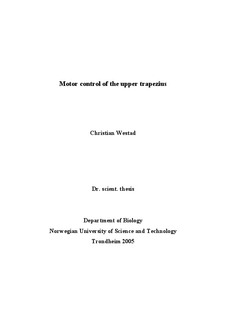| dc.contributor.author | Westad, Christian | nb_NO |
| dc.date.accessioned | 2014-12-19T13:10:58Z | |
| dc.date.available | 2014-12-19T13:10:58Z | |
| dc.date.created | 2005-06-10 | nb_NO |
| dc.date.issued | 2005 | nb_NO |
| dc.identifier | 126019 | nb_NO |
| dc.identifier.isbn | 82-471-7033-7, h., 82-471-7032-9 | nb_NO |
| dc.identifier.uri | http://hdl.handle.net/11250/244532 | |
| dc.description.abstract | Background The main objective of this thesis was to establish new insight into the motor control of low-threshold motor units in the trapezius muscle. Special attention was given to motor unit recruitment threshold related to firing behavior. The extensive literature on motor control mainly concerns firing behavior of extremity muscles. Motor control of the upper trapezius shows features that indicate deviations from the control scheme generally assumed to apply to muscles of the extremities. Knowledge of motor control of the trapezius is important in a pain development perspective, since shoulder/neck complaints are frequently localized to this muscle.
Methods Constant amplitude contractions of 2 to 30 min duration, with amplitudes between ~2–7% of maximal voluntary contraction (2-7% EMGmax), were used to study time-dependent changes in motor unit firing. Transient force increases reaching 15-20% EMGmax were superimposed on some of these contractions in an attempt to induce motor unit substitution. Sinusoidal contraction profiles were used to study firings in response to dynamic contractions. Motor unit firing was studied in 10 min contractions with vocational (typing) tasks and mental stress. The spike-triggered averaged (STA) technique was used to examine motor unit potentials and their dependence on contraction amplitude and firing history. The individual motor unit firings were recorded by intramuscular fine wire electrodes, while simultaneously recording the surface electromyographic (SEMG) signal. The Precision Decomposition technique was used to identify individual motor units with near 100% accuracy.
Results The results show that some low-threshold motor units stopped firing at the end of the EMG-pulses while motor units with initially higher threshold were recruited or stayed active. The lowest threshold motor units showed only brief silent periods. The mean firing rate increased from 10.5 to 12.5 pulses per second (pps) in response to contraction amplitudes of <2% and >4% EMGmax, but the mean firing rate the same for all motor units regardless of task and recruitment threshold given the SEMG amplitude. There was a strong rate modulation in dynamic contractions. STA-derived motor unit potentials indicated that motor units recruited below EMGmax had similar area at the same contraction amplitude. However, the area increased four-fold when SEMG amplitude increased from 1.5 to 10% EMGmax. Motor unit synchronization showed an average of 2.8% additional firings within of the triggering motor unit, estimated by peristimulus time histograms (PSTHs). A surprising finding was respiratory modulation of the firing rate at low contraction amplitudes. This modulation was attenuated by induced mental stress.
Conclusions Transient force increases promote derecruitment of motor units and may be attributed to inactivation of non-inactivating inward currents (plateau potentials). Silencing of motor units can be considered a protective mechanism to reduce the metabolic load on low-threshold motor units. The similar firing rates in sustained contractions independent of task and recruitment threshold suggest that the duration and pattern of silent periods are the most important variables to investigate in relation to motor unit over-exertion and subsequent pain development. The strong rate modulation in response to dynamic contractions indicates a control strategy resembling that of extremity muscles. STA-derived motor unit potentials indicate that units recruited below 10% EMGmax are of similar size, thus suggesting a deviation from the Henneman size principle. This may be an adaptation to postural functionality. The increase in STAderived potentials is largely due to motor unit synchronization. This points out limitations for this method when quantifying motor unit size, numbers and conduction velocity. Finally, respiratory modulation of firing rate and the attenuation by mental stress suggest at least two different sources of autonomic input that may facilitate motor unit activity. | nb_NO |
| dc.language | eng | nb_NO |
| dc.publisher | Fakultet for naturvitenskap og teknologi | nb_NO |
| dc.relation.ispartofseries | Doktoravhandlinger ved NTNU, 1503-8181; 2005:80 | nb_NO |
| dc.relation.haspart | Westad, Christian; Westgaard, RH; De Luca, CJ. Motor unit recruitment and derecruitment induced by brief increase in contraction amplitude of the human trapezius muscle. The Journal of Physiology. 552(2): 645-656, 2003. | nb_NO |
| dc.relation.haspart | Westad, Christian; Mork, PJ; Westgaard, RH. Firing patterns of low-threshold trapezius motor units in feedback-controlled contractions and vocational motor activities. Experimental Brain Research. 158(4): 465-473, 2004. | nb_NO |
| dc.relation.haspart | Westad, Christian; Westgaard, RH. The influence of contraction amplitude and firing history on spike-triggered unit potentials averaged trapezius motor. The Journal of Physiology. 562(3): 965-975, 2004. | nb_NO |
| dc.relation.haspart | Westgaard, RH; Bonato, Paolo; Westad, Christian. Respiratory and stress-induced activation of low-threshold motor units in the human trapezius muscle. The original publication is available at www.springerlink.com) Experimental Brain Research. 175(4): 689-701, 2006. | nb_NO |
| dc.subject | Muskler | no_NO |
| dc.title | Motor control of the upper trapezius | nb_NO |
| dc.type | Doctoral thesis | nb_NO |
| dc.contributor.department | Norges teknisk-naturvitenskapelige universitet, Fakultet for naturvitenskap og teknologi | nb_NO |
| dc.description.degree | dr.scient. | nb_NO |
| dc.description.degree | dr.scient. | en_GB |
